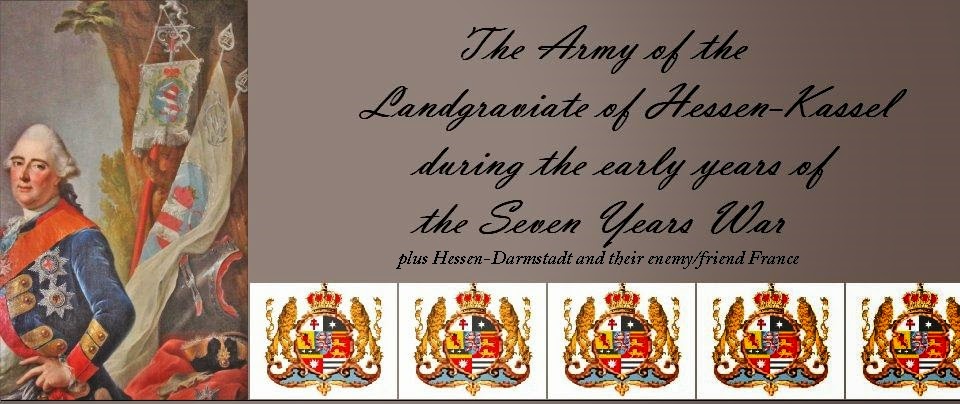Sunday 15 September 2013
Landgrave William VIII
William VIII of Hesse-Kassel was born on March 10, 1682 in Kassel, and died on February 1, 1760 He ruled as Landgrave of Hesse-Kassel from 1751 until 1760.
William was the sixth son of Landgrave Charles of Hesse-Kassel (1654-1730) from his marriage to Marie Amalia (1653-1711), daughter of Duke Jacob Kettler of Courland. They had seventeen children in total!
After a customary Prince’s education he undertook his Grand Tour which included visits to Geneva and Paris. Together with his older brother, Charles (1680-1702), he participated in the WSS in the service of the Republic of the Seven United Provinces ("Holland") and began his military career, which was helped by the fact that his godfather was William III of Orange. In 1709 he became a lieutenant-general and four years later Governor of Breda. In 1723 he was appointed Governor of Maastricht (a crucial barrier fortress) and, finally, in 1727 promoted to the rank of Dutch cavalry general. In 1747 he resigned his commission in the United Provinces. After his older brother Frederick was crowned King of Sweden in 1720 and the death of his father in 1730, William took over the administration of the country as regent for his brother. Under William's reign the Hessian army was increased to 24,000 men. After the death of his brother Frederick in 1751 William succeeded him as the reigning Landgrave.
William married on 27 September 1717 Dorothea Wilhelmine (1691-1743), daughter of Duke Moritz Wilhelm of Saxe-Zeitz, and they had three children:
Charles (1718-1719), Frederick II (1720-1785) and Maria Amalie (1721-1744)
In 1736, by inheritance, the county of Hanau was joined to the Landgraviate of Hessen-Kassel after the last Count Johann Reinhard III had died.
William was a personal friend of both the Prussian King Frederick II of Prussia as well as the brief Bavarian Emperor Charles VII. He signed an agreement with Charles in 1742 in Frankfurt whereby 3,000 Hessian soldiers (another source shows 6,000 men) were offered in exchange for a guarantee of the integrity of all the Electoral territories. This led to the bizarre situation where 6,000 Hessian troops were serving with the Pragmatic (British allied) army in Flanders in support of Maria Theresa's inheritance while another 6,000 troops were serving the Bavarian Emperor in central Germany against the army of Maria Theresa. The agreement with the Bavarians for the first time included a blood money clause providing extra compensation for dead and wounded. Despite serving on both sides the Hessians sustained and enhanced their reputation for rock steadiness. In 1745 and again in 1756, Hessian regiments were shipped out to a Britain fearful of invasion by French and Scots. Landgrave William clearly viewed them as a financial resource when he said: "These troops are our Peru. In losing them, we would forfeit all our resources."
On June 18 1754, during his sojourn on the continent, King George II of Great Britain concluded another treaty with Hessen-Kassel. By this treaty, Hessen-Kassel had to supply 6,600 foot and 1,400 horse to serve in the British service (this force could be increased to 12,000 men upon the king's request). The treaty stated that each battalion of foot should have 2 guns. These troops would not serve aboard the fleet or overseas. (Hessian forces had served in Great Britain during the Jacobite rebellion in other words 'overseas' and would do so again during the American Revolution so this later clause must have been revised at some stage).
Of domestic political importance was his son's (the future Landgrave Frederick II) change of religion to Catholicism in 1749 which some have attributed to his desire to become King of Poland. It was the reigning sovereign's right to determine the form of state religion (under William this was Calvanist) and this required negotiation between William, his son and the Hessian estates in 1754 which resulted in a number of regulations whose central element was the 'Assekurationsakte' . This stipulated that there would be no public Catholic worship, that Catholics were prevented from occupying any state administrative offices and even limited to one catholic officer per foot regiment. In addition, the county of Hanau was separated from Hessen-Kassel's ownership and bypassed Frederick going instead to his son, the future Landgrave William IX. With all these provisions in place Frederick would be able to inherit the Landgraviate on the death of his father in 1760 without serious difficulty. It was Hessen-Kassel's own mini-pragmatic sanction.
At the start of the SYW William was 74 years old so too old to take command of his own forces. He sided with Prussia and Britain with his army serving in the Western theatre of the war. This meant that the country became an important battlefield and consequently suffered severe devastation. Among other things, the French occupied Kassel several times.
Under William the foundation stone for the Schloss Wilhelmsthal was laid in 1753. He was also the founder of the Kassel Art Gallery and was quite an avid collector of Old Masters.He summoned the painter Johann Heinrich Tischbein (who painted the painting at the top of this blog which is of the future Landgrave Frederick II in the uniform of Prussian regiment 45 of which he was honorary colonel) and the sculptor Johann August Nahl at the Kassel court and encouraged the builder Simon Louis du Ry .
Subscribe to:
Post Comments (Atom)




No comments:
Post a Comment